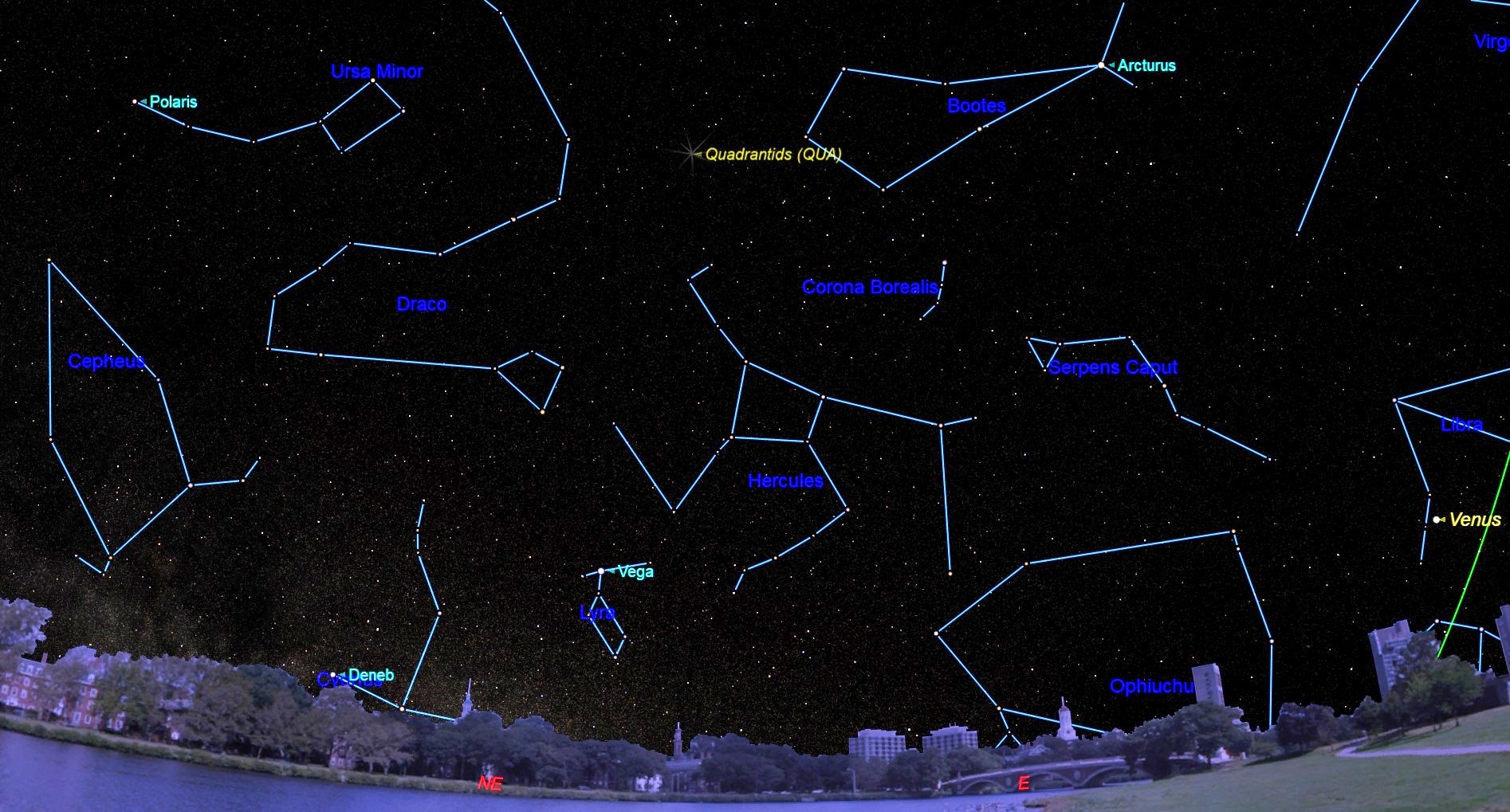Bountiful Quadrantid Meteor Shower of 2019 Hits North America at Wrong Time

Of the dozen or so annual meteor showers, only three produce rates possibly numbering over 100 per hour: August's Perseids, December's Geminids and — due to peak late this week — January's Quadrantid meteor shower.
Each year, the Earth briefly encounters that meteor shower in the first week of January. Quadrantid meteors appear to fan out from a spot on the sky midway between the Big Dipper's handle and the four stars marking the head of Draco, the dragon. And here's the story behind the meteors' unusual moniker: There was at one time a dim, shapeless star pattern known as Quadrans Muralis, the "wall quadrant." The pattern was pictured on many 18th- and 19th-century star atlases but is now defunct. Its stars have since been redistributed among the constellations of Boötes, Draco and Hercules.
The main challenge with the Quadrantids is catching them when they are active, because they are a very short-lived display. The Quadrantids characteristically spend only about 12 hours rising from quarter-strength to peak activity. The subsequent decline takes as little as 4 hours. Different hemispheres of the Earth often see the Quadrantids appear in dramatically different numbers. [Quadrantid Meteor Shower 2019: When, Where & How to See It]
According to the "Observer's Handbook" of the Royal Astronomical Society of Canada, the peak this year is predicted to come at around 0300 GMT on Friday, Jan. 4, which is good for Europe and areas east into Central Asia, where 60 to 120 meteors per hour are expected under ideal conditions.
But from North America, we'll face the "wrong way" when this shower reaches its peak. The time 0300 GMT corresponds to the evening of Thursday, Jan. 3, in North America, where incoming meteoroids will be mostly blocked from view by the planet Earth. Put another way, the meteor radiant will appear very low above the northern horizon, and consequently very few meteors will be visible.
However, in the past, outbursts of "Quads" have sometimes been seen several hours early or late, so it always pays to be on the lookout. The predicted peak corresponds to 10 p.m. EST and 7 p.m. PST.
While it's certainly true that meteors are few and far between when the meteor radiant is barely rising above the horizon, the meteors that do appear are usually spectacular "earthgrazers" that skim along the upper atmosphere and travel far across the sky. Just seeing one of these can make your night worthwhile. So, keep an eye out Thursday evening. Any Quadrantid earthgrazers will fly from out of the north-northwest part of the sky at nightfall: from almost due north around 8 or 9 p.m. and from the north-northeast from 10 p.m. to midnight in your local time zone.
Get the Space.com Newsletter
Breaking space news, the latest updates on rocket launches, skywatching events and more!
Not until 1 a.m. will the radiant climb well up into the northeast; it's highest before dawn. The meteors that appear after the peak tend to be brighter than the early ones, indicating that the larger particles are on the outer side of the meteoroid stream. These meteors have been described as medium speed and reasonably bright and usually tinted blue. But only a few — maybe 5 to 10 percent — leave fine, long-spreading and persistent silver trains.
And a final note (or is it a reminder?) — it's January, the coldest month of the year. So, if you plan to hunt for some Quads, remember to bundle warmly!
And good luck!
Editor's note: If you snap an amazing photo of the 2019 Quadrantid meteor shower that you'd like to share with Space.com and our news partners for a possible story or image gallery, send comments and images in to: spacephotos@space.com.
Joe Rao serves as an instructor and guest lecturer at New York's Hayden Planetarium. He writes about astronomy for Natural History magazine, the Farmers' Almanac and other publications, and he is also an on-camera meteorologist for Verizon FiOS1 News in New York's lower Hudson Valley. Follow us on Twitter @Spacedotcom and on Facebook. Original article on Space.com.
Join our Space Forums to keep talking space on the latest missions, night sky and more! And if you have a news tip, correction or comment, let us know at: community@space.com.

Joe Rao is Space.com's skywatching columnist, as well as a veteran meteorologist and eclipse chaser who also serves as an instructor and guest lecturer at New York's Hayden Planetarium. He writes about astronomy for Natural History magazine, Sky & Telescope and other publications. Joe is an 8-time Emmy-nominated meteorologist who served the Putnam Valley region of New York for over 21 years. You can find him on Twitter and YouTube tracking lunar and solar eclipses, meteor showers and more. To find out Joe's latest project, visit him on Twitter.









